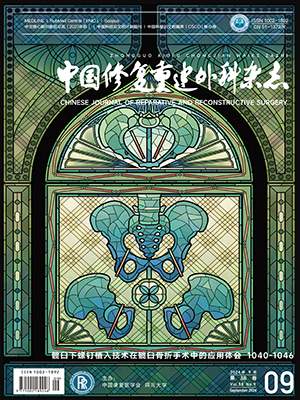Object ive To explore a method to recons t ruct eccr ine sweat gland- l ike s t ructure in vitro. Methods Isolated from the normal axillary full-thickness skin donated by volunteers sweat gland epithel ial cells were cultured in vitro and were observed under inverted phase contrast microscope. These cells at the density of 2 × 105/cm2 were inoculated underneath the Matrigel (group A), on the top of the Matrigel (group B) and in the Matrigel (group C), respectively,
for three-dimensional culture. The formation of eccrine sweat gland-l ike structure was observed by confocal laser scanning microscope, HE staining and immunohistochemistry staining. Results Primary epithel ial cells in the secretory portion of sweat gland were attached and spindle-shaped 24 hours after inoculation, and were under polyclonal grain-l ike growth 2-3 days thereafter. Cobblestone-l ike appearances of these cells were evident 14 days after inoculation and the confluent cells were flat and polygonal with relatively big round cell nucleus. Morphologically, subcultured cells at passage 1 were similar to the primary cells; cells at passage 2 were irregular and most of them had long pseudopodium; cells at passage 3 were star-shaped and big and had fusion with adjacent cells. For group A, tubular structure was formed 11 days after three-dimensional culture. For group B, stretched and filamentous-shaped cytoplasm was observed 8 hours after three-dimensional culture, with the formation of lumen or half-lumen structure, but no significant prol iferation was evident. For group C, cell division and prol iferation occurred 2-3 days after three-dimensional culture; the prol iferated cells were closely arranged into tubular structure with obvious lacunae in the middle, which gradually developed into irregular ball-shaped structure with the increase of neonatal cells. The laser scanning confocal microscope observation showed the formation of spherical structure in group C, with tubular structure in the center of cell mass; HE staining testified the spherical structure in group C was tubular structure. The immunohistochemistry staining demonstrated keratin 18 and carcinoembryonic antigen were positively expressed in group C, which was similar to the tubular structure of secretory portion of sweat gland. Conclusion The sweat gland epithel ial cells can be induced to form eccrine sweat gland-l ike structure through three-dimensional culture in Matrigel.
Citation: ZHOU Lifeng,WU Jinjin,LEI Xia,LU Rong,LU Yuangang,TANG Shuqian. PRELIMINARY STUDY ON FORMATION OF ECCRINE SWEAT GLAND-LIKE STRUCTURE IN THREEDIMENSIONAL CELL CULTURE. Chinese Journal of Reparative and Reconstructive Surgery, 2009, 23(2): 156-160. doi: Copy




